LED lamps “ASD”: review of the model range + selection tips and reviews
Do you want to realize stunning designer ideas using ASD LED lamps to design original architectural projects? Agree, a unique atmosphere skillfully created by the play of light in LED bulbs can give the interior a special meaning and surprise friends and acquaintances.
But the implementation of your home lighting plans is hindered by doubts about the advisability of purchasing ASD products?
We will help you understand this issue - the article discusses the design features of the manufacturer's LED products, the model range of light bulbs, their pros and cons, based on consumer reviews.
The material is supplied with visual photographs with samples of ASD products, and recommendations are given for choosing LEDs for domestic use, taking into account the characteristics of the room that requires lighting.
To simplify the selection process, we also suggest that you familiarize yourself with a detailed video review of light bulbs and an analysis of the advantages performed by the user in the video.
The content of the article:
Pros and cons of LED lighting
An LED is a miniature semiconductor device whose task is to convert electrical energy into rays of artificial light.
This function is performed by crystals grown in a special way, which have maximum light output and minimal energy consumption. Diodes serve as both primary and additional light sources.
The ability to shine brightly, powered by a minimum of electric current, could not but interest developers of lighting projects for walking areas, public spaces, industrial and commercial facilities.
It also attracted manufacturers of instrument panels for various types of machines with equipment, and manufacturers of household devices with backlighting for convenient operation at night.
Quite rightly, the advantages of the LED group of devices include:
- Practicality. An LED device consumes 10–15 W/h, which is significantly less than the energy consumption of a fluorescent light bulb of similar power. The service life is characterized by impressive figures of 30,000 - 100,000 hours.
- Minimum heating. The design of the diode bulb ensures regular removal of heat generated during operation of the device. Therefore, LEDs have excellent contact with any materials, making them freely used in built-in lighting circuits.
- Variety of sizes and shapes. Available on the market wide range of LED luminaires, designed to solve various technical problems.
- Environmental benefits. LED devices are attractive due to their safety, because... do not contain mercury or other toxic components harmful to the user’s body. Their disposal does not require compliance with safety measures as for fluorescent lamps.
- Strength. The housing and components of the diodes are characterized by high mechanical strength. Their bulbs are noticeably more reliable than incandescent bulbs. In addition, there are no parts that suffer from vibration like tungsten filaments.
- Savings during installation. Due to low power consumption, LED lighting uses wiring with a cross-section smaller than the usual dimensions used in circuits with incandescent lamps.
- No flicker. LEDs from a responsible manufacturer do not flicker and therefore do not have an extremely harmful effect on the eyes of people present in the room.
It should be noted that when LED bulbs are turned on, there is no network overload, as happens when luminaires with incandescent bulbs are activated. At the same time, the luminous flux reaches 95%, while the same competitors have only 60-75%.
LED devices do not emit ultraviolet radiation, but there is still infrared glow in a minimum safe volume.
The list of advantages includes a wide spectral range, although the characteristics of their glow are still dominated by cold white rays.
There are not too many disadvantages of diode light bulbs, but we still cannot do without them. The price of lighting devices cannot but surprise, especially those who are not familiar with their specifics. If we take into account the quick payback of LED lighting circuits, then this drawback becomes controversial.
Similar disadvantages, which can be regarded as advantages in some cases, include the direction of the light flux.
For ordinary lamps, especially for their wall types, this is a clear minus; for spotlight options, this is a clear plus.After all, the light is concentrated in one directional beam.
When connected to an industrial frequency network, LEDs will still flicker, and even more strongly than their fluorescent counterparts. Some reasons blinking LED lights You can find out and fix it yourself.
Occasionally, during their operation, electrical noise is noted, for example, arising from interference.
For normal operation, a diode light bulb requires a clearly standardized voltage. To provide the device with the rated operating current, it is supplemented with complex electronic components called current sources.
As a result, the complexity of the circuit increases the cost of constructing LED lighting.
In the simplest cases of using diodes, they can be connected to a DC network, but through a resistor.
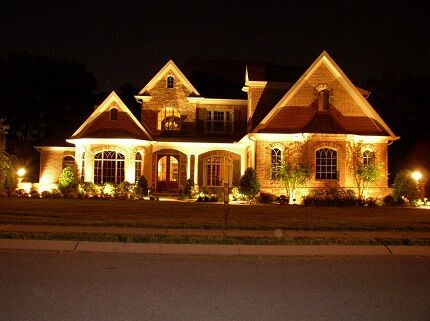
A significant disadvantage of LED devices is the lack of ability to change light transmission. Therefore, they are practically not used in circuits with the ability to adjust the brightness of lighting.
Only certain types of expensive products can work in tandem with dimmers, reducing the light flux of the diodes, and then by a maximum of 20%.
Review of ASD brand LED products
Considering that a significant amount of advantages unconditionally outweighs the disadvantages of diodes, the demand for them is steadily growing.
Among the devices actively in demand on the domestic market, ASD products occupy one of the significant places. The manufacturing company diligently strives to cover the basic needs of the consumer.
Let's look at how to understand the assortment of this brand, what characteristics it is ready to please the future owner, and what to disappoint.
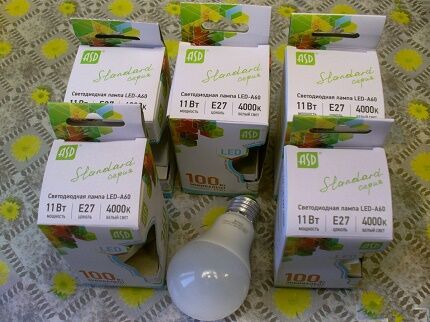
Light bulb standards
The designs of all LED devices known today use almost the same components. The difference lies in their size, and sometimes in the quality of their components.
IN light bulb designs ASD used:
- Group of LED chips. Their total power is the direct power of the lighting device.
- Control device. Provides switching on/off of the light bulb from the network, and also stabilizes the current supplied to the luminous crystals.
- Frame. A flask made in the shape of a pear, ball, candle flame or tube, equipped on the working side with a reflector, and on the reverse side with a radiator for heat removal.
LED chips are mounted on an aluminum board, which acts as a base for installing crystals and a device for removing heat flow from the diodes to the radiator area.
Unhindered and regular cooling of the working body significantly extends its working life.

Depending on the power, size and purpose of the lamp, there can be from one to several dozen diodes in the device.
Diodes are connected to the control device either in parallel in a “chain” or in series, i.e. each separately. The first option is simpler and therefore cheaper, the second is more complex and much more expensive.
The connection is made through a resistor and a driver, which is responsible for supplying the current values required for the device.
In light bulbs with diodes connected in parallel, each element is equipped with its own resistor, which explains their complexity and considerable price.
But if one chip fails, the rest will continue to work, and with a parallel version, the entire device will be damaged.
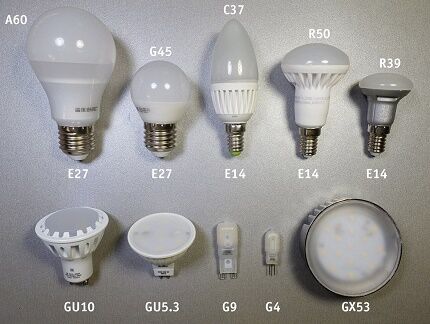
Variations on the theme of brightness are obtained through the use of optical parts that differ in properties: diverging and focusing lenses. By this method, light emission is either amplified and concentrated into a beam, or scattered.
LED light bulbs for household use are produced with standard bases: threaded and pin. Thanks to this, they can easily replace a burnt-out incandescent lamp in an AC power supply line.
ASD LED range
LED devices with the specified logo are produced in flasks made of matte or transparent light-conducting material.
The assortment includes options with pear-shaped, spherical, tubular bodies, as well as LEDs made in the form of a candle, a directional light source with a reflector, and other types.
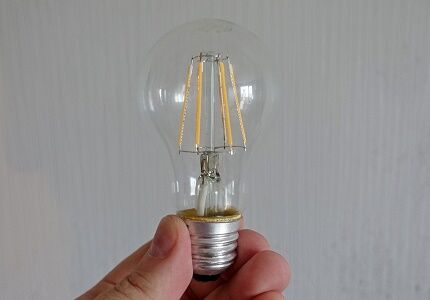
Based on the type of base for LED chips and the mounting to it, lamps are divided into models created using the following technologies:
- SVD — the working elements are attached to a rigid board located in the center of the device in a serial or parallel order;
- OWL or they LED-filament — LED chips in them are fixed on glass, sapphire or metal strips with a phosphor coating.
Among the sales offers from the described company there are no light bulbs made in accordance with the technology Crystal Ceramic MCOB, but it is possible that the range will soon be replenished with such products.
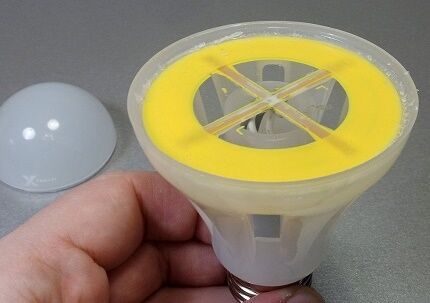
According to this technology, instead of a metal board, a transparent ceramic plate with a phosphor coating is placed in the center of the device.
Chips are fixed on both sides of the plate. This arrangement ensures an even supply of light in all directions.
Guidelines for choosing a light bulb
The packaging of LED products from ASD indicates LED lamp characteristics, which you need to study in order to make an intelligent purchase.
In terms of energy efficiency class, all devices offered for sale are marked with the letter A, which means that their high performance is combined with moderate energy consumption.
The company assures that it does not produce devices of a lower class, of which there are seven in international standardization.
The least efficient are bulbs with the letter G in the marking, which is almost impossible to find in the characteristics of LEDs from any company.
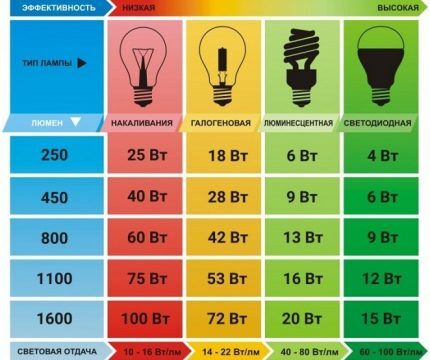
Characteristics that require mandatory consideration before purchasing include:
- Power. Diodes shine approximately 10 times stronger than incandescent lamps and approximately 2 times stronger than fluorescent devices. In order to get a real idea of the luminous flux in W, the power of the LED light bulb must be multiplied by 9-10.
- Power supply voltage. Its parameters must correspond to the characteristics of the network to which the device will be connected. Do not try to use an LED in a line with a different voltage, as this may damage it or cause a short circuit.
- Colorful temperature. For installation in residential premises, it is better to use lamps of a pleasant warm color of 2700 L; diodes of 3000 L are suitable for utility rooms. Devices with a cold emitting spectrum, over 3000 L, are purchased for street lighting and for industrial floodlights.
- Color transfer. The higher the color rendering index, the better the lighting reproduces real color. It is indicated in the marking with the letters CRI, followed by a numerical expression from 0 to 100 Ra units. The products of this manufacturer are marked 90 Ra.
- Scattering angle. Depends on the design features of the light bulb; for LED devices it varies from 30º to 360º. Typically, LEDs with a dispersion angle of up to 90º are selected for spot wall and ceiling lamps, for wall sconces - up to 180º, for table lamps - up to 180º.
Among the important indicators that should be taken into account before purchasing is also the base. ASD light bulbs are produced for standard threaded and pin sockets; in order to find out this characteristic, just look at the device to be replaced.
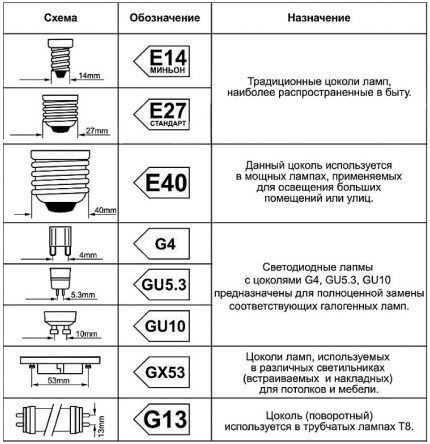
You should take into account the period promised by the manufacturer for the flawless operation of the LED. Note that during operation the lamp will gradually lose brightness, and when the life is almost exhausted, it will generally shine dimly. This means the LED bulb needs to be replaced.
Violations of the rules of use can contribute to accelerated wear, for example, operation in a temperature range not declared by the manufacturer or installation in a room not intended for LED lighting.

Consumer reviews of products
LED light bulbs with the ASD logo attract customers with affordable prices. However, owners of economical lighting devices often experience some disappointment and dissatisfaction.
Inexpensive products, unfortunately, are still noticeably inferior to offers from Philips or Osram.
Main disadvantages:
- Discrepancy between actual power parameters declared by the manufacturer. The luminous flux emitted by the bulbs is weaker than promised by the labeling.
- Insufficient color rendering. According to the results of the tests, the CRI characteristic is on average 70 Ra, which suggests the use of low-grade diodes.
- Incorrect service life, overestimated by the manufacturer by approximately one and a half to two times.
However, our unspoiled compatriot is not yet too picky about the quality of products that are poorly familiar to him; many are quite satisfied with what they have, which is also complemented by a relatively low price.
Most consumers admit that ASD LEDs “earn back” the money paid for them. They agree that if a product costs little, it doesn’t have to be high quality.
Such an attitude is a serious mistake that will not encourage the manufacturer to produce a worthy product.
Note that Europe has a completely different approach to spending its own funds. If the light bulb has not worked for the period specified by the manufacturer and fails ahead of time, the seller of the device is obliged to replace it.
The same is done if other defects are detected: low luminous flux, incorrect color rendition.
It’s time for buyers from the CIS countries who are inexperienced in these matters to become stricter and more picky in order to receive high-quality products at a reasonable price.
Conclusions and useful video on the topic
Video with an overview of the 11 W Standard series LED light bulb:
Evaluation of the pros and cons of a 15 W diode lighting device:
LED disassembly guide:
Information about the specifics of choosing an LED lamp and the manufacturing features of devices from the ASD company will help you correctly select and buy a light source with the necessary characteristics.
Are you looking for economical and reliable LED light bulbs? Or do you have experience using ASD lamps? Please leave comments on the article, ask questions and participate in discussions. The contact form is located below.




I use LED lamps at home. The first advantage of such lamps is the reduction in electricity consumption, which brings significant savings in money. In addition, the lamp gives a pleasant, albeit somewhat harsh, light, but you can get used to the spectrum. Of course, you will have to pay a lot for LED lamps, but everything pays off quite quickly.
ASD is a good and proven brand among LED lamps. They are one of the pioneers in this field. I remember those times when lamps were 500 rubles apiece. But time has passed, and now each of us can afford an LED light bulb. My opinion about ASD is: high quality and reasonable price on the market.
Well, here everything is as always - the manufacturer promises one thing, but in fact the consumer receives something completely different. Basically, what you paid for is what you got. No one will (and does not know how) to find out the true color rendition and real power. The maximum thing people will pay attention to is the service life. But, I’ll tell you, it varies from product to product for any manufacturer.
Bad lamps. During the year it was replaced 3-4 times under warranty. And yet they burned down after a few months.